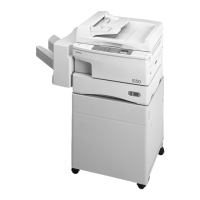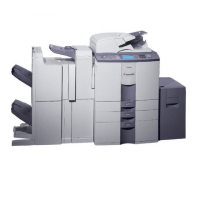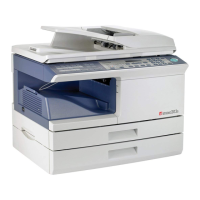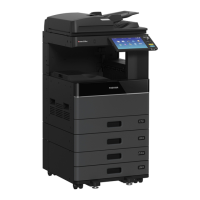Do you have a question about the Toshiba 8070 and is the answer not in the manual?
Detailed technical specifications of the copier, including copy speed and paper handling.
Lists optional accessories provided with the copier, such as unpacking instructions and manuals.
Lists optional hardware components for enhancing copier functionality, like finishers.
Lists consumable parts required for the copier's operation, such as toner and developer.
Provides diagrams illustrating the system configuration and interconnected components.
Detailed sectional views showing the internal structure and location of various machine parts.
Diagrams illustrating the layout of electrical components within different units of the copier.
Lists symbols and their corresponding functions for motors, solenoids, sensors, and other components.
Explains the step-by-step process of image formation and copying within the machine.
Provides detailed explanations of each stage of the copying process, including drum and charging.
Compares the copying process conditions and specifications between different copier models.
Provides a general overview of copier operation modes, including warm-up and copying.
Details the operational steps for warming up, standby, automatic feed, bypass, and interrupt copying.
Explains how faults are detected, classified, and provides explanations for common faults.
Presents flowcharts illustrating the operational logic for power-on readiness and automatic feed copying.
Illustrates the control panel layout and the LCD display for operation status and messages.
Lists and explains messages displayed during normal operation and fault conditions.
Shows the relationship between copier conditions and operator actions for various operations.
Describes the circuitry and operation of the dot matrix LCD and LED display systems.
Provides step-by-step instructions for disassembling and replacing control panel components.
Introduces the image processing stages from scanner to printer, highlighting ASIC functions.
Details the image processing circuit configuration, including SLG and PLG boards.
Explains the features and functions of the SLG board, including image processing capabilities.
Details the functions of the PLG board, covering smoothing, interface, and laser control.
Describes the scanner's role in image processing, including light conversion and A/D conversion.
Explains the printer's role in laser writing and image area control based on processed signals.
Describes the scanner's function in converting reflected light into electrical signals for image processing.
Details the configuration of the optical system and the purpose of its components.
Explains the operation of the scanning motor, document motor, and optical fan motor.
Details the features and principle of the 5-phase stepping motor used in the scanner.
Explains the exposure control circuit, including lamp regulator and sensor adjustments.
Outlines the control processes, including photo-voltaic conversion and shading compensation.
Describes the circuit for automatically detecting the size of the original document.
Provides instructions for disassembling and replacing scanner unit components.
Outlines how the laser optical system irradiates the drum to produce a latent image.
Details the structure of the laser unit, including diodes, lenses, apertures, and safety precautions.
Describes the semiconductor laser diode used, its characteristics, and control circuits.
Provides instructions for disassembling and replacing parts of the laser light unit.
Provides a general overview of the paper feed system, its functions, and main sections.
Details the aligning section, including rollers, switches, and drive mechanisms for paper alignment.
Explains the construction, operation, and components of the Large Capacity Feeder.
Describes the PFP's components, including cassettes, elevator, and paper feed mechanisms.
Describes the construction of the drum and related parts, including the main charger and discharge LED.
Explains the functions of the drum, main charger, charger wire cleaner, and discharge LED.
Provides procedures for disassembling and replacing the drum, main charger, and charger wire.
Describes the construction of the belt transport unit, excluding the fuser unit.
Explains the operation of the transfer belt, including its contact and separation with the drum.
Details the functions of the transfer belt unit components like cleaning blade, brush, and auger.
Provides instructions for displaying and replacing the belt transport and transfer belt units.
Provides a general description of the developer unit and the developing process.
Details the construction of the developer unit, including sleeves, leveler, and mixing unit.
Illustrates the gear train and drive mechanisms for the developer unit.
Details the IC motor and developer motor drive circuits and their operation.
Explains the auto-toner sensor circuit for maintaining toner density and detecting toner-empty status.
Provides instructions for disassembling and replacing the developer unit and its components.
Describes the construction of the cleaner unit, including blades, brushes, and toner bag.
Explains the functions of the cleaner unit components like main blade, recovery blade, and toner bag.
Details the circuit for detecting drum temperature and its control signals.
Explains how the toner adhesion sensor controls image quality by adjusting formation conditions.
Provides instructions for disassembling and replacing cleaner unit components.
Provides a general description of the fuser unit and its role in fusing toner to paper.
Explains the fuser's operation, including heat, pressure, and separation of paper.
Details the functions of fuser unit components like heater lamps, rollers, and cleaning rollers.
Explains the heater control circuit, temperature detection, and abnormal heater condition management.
Details the heat-roller motor drive, including its operation and control signals.
Provides instructions for disassembling and replacing fuser unit components like rollers and lamps.
Introduces the ADU's function for automatic duplex copying and stacking up to 60 copies.
Details the drive mechanisms for various ADU sections, including gates, rollers, and clutches.
Explains the paper stacking and duplex copy (re-feed) operations within the ADU.
Provides instructions for disassembling and replacing ADU covers and units.
Outlines the ADF's function in feeding originals and its main sections: feed, transport, and exit.
Details the ADF construction, listing mechanical and electrical components by section.
Explains the ADF operation for setting originals, alignment, and various transport modes.
Describes the interface signals used for communication between the copier and the ADF.
Details the detection methods for paper jams in the ADF's feed and transport sections.
Explains the method used by the ADF to detect the size of the original document.
Provides flowcharts illustrating the ADF's main routines and operational controls.
Presents timing charts for various ADF operations, showing signal sequences.
Lists symbols for motors, solenoids, sensors, and shows electrical parts layout and signal blocks.
Describes various circuits within the ADF, including sensor inputs and motor drives.
Details the input/output signals for communication between the copier and the ADF.
Provides instructions for disassembling and replacing ADF unit components.
Describes the configuration of the power supply unit, including AC filter and DC output circuits.
Explains the operation of DC output circuits, including start-up, stop, and protection features.
Shows the layout of the PWA-F-SYS-300 PC board.
Shows the layout of the PWA-F-MTB-300 PC board.
Shows the layout of the PWA-F-LGC-300 PC board.
Shows the layout of the PWA-F-ADU-300 PC board.
Shows the layout of the PWA-F-MOT-300 PC board.
Shows the layout of the PWA-F-SLG-300 PC board.
Shows the layout of the PWA-F-SDV-300 PC board.
Shows the layout of the PWA-F-PLG-300 PC board.











